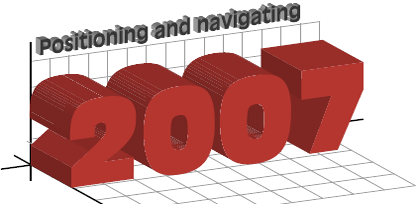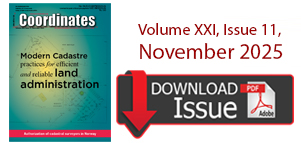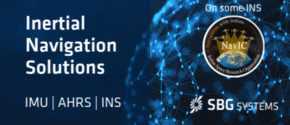
|
A cross section of views by leading experts on the possibilities and priorities in Geomatics and GNSS in the year ahead
|
|
|
|
The cell phone GPS market is growing huge
|
 Akio Yasuda Akio Yasuda
Professor Laboratory of Communication Engineering, Tokyo University of Marine Science and Technology, Tokyo, Japan QZSS is a Japanese Satellite System to augment the performance of GPS positioning. It was expected to provide the services of positioning, communication, and broadcasting.
The schedule of the development delays for waiting the decision of the private sector to invest the new data service. But they gave up the communication and broadcasting services which are originally planned to be installed to QZSS early last year. The first satellite shall be launched in the summer of 2009 being prepared by JAXA (Japan Aerospace Exploration Agency). And after proving the effectiveness by the first satellite, the following satellites will be launched and the full system will be furnished: i.e. the users will be able to receive the signals from the zenith continuously for 24 hours.
It will transmit the L1-SAIF (L1- Submeter-class Augmentation with Integrity Function), which provide the correction data at 250 sps of code ranging to obtain sub-meter positioning accuracy besides the supplement of the modernized GPS signals.
It will also provide the data through the LEX (experimental signal with higher data rate of 2kbps of message), compatibility with Galileo E6 signal at 1279 MHz. This channel will be devoted to the transmission of the carrier measurements data for RTK-GPS positioning.
The format of the L1-SAIF is followed by SBAS data, but the data is designed specifically for Japanese area. It has been tested experimentally and proved to the performance of sub-meter accuracy. The test will be continued to complete the total system, including the user segment, until the end of 2008. The LEX will convey the data for the network-based RTK-GPS usable all over the Japanese Islands. The details, including the format, are under examination. The applications of the GPS positioning using QZS to the various fields are now under development.
As for the user segment, it will be requested from this April to add the positional data in sending the emergency messages by cell phones (so called Japanese version of E-911).
It means that all the cell phones must have the positioning function. The environment of the GPS reception in the urban area is usually poor and signals are weak with sever multipath.
The high sensitive GPS receivers with low cost are installed for the first generation of cell phone with GPS. The sever multipath must be reduced to get very accurate positioning. The improvement of GPS itself is continuing. The cell phone GPS market is growing huge, as more than 10 million cell phones will be replaced by newer versions every year. The desire for highly accurate positioning with lower cost never stays. The higher the accuracy, the wider the application fields. The carrier phase positioning with cm level accuracy including new GNSS, such as Galileo and QZSS, is being examined for higher performance. |
|
|
|
Competition and harmonization is expected in GNSS
|
 Prof Sang Jeong Lee Prof Sang Jeong Lee
Chungnam National University, Korea With the successful take-off of Galileo and renewed GLONASS, competition and harmonization is expected in GNSS. Since most countries rely on external systems for PNT services, they are likely to want to involve in the operation of GNSS through international cooperation as national PNT infrastructure dependence grows rapidly. Korea also will want to find ways for international cooperation with GPS, Galileo and QZSS. With modernized GPS signals, renewed GLONASS and the Galileo ICD, the convergence trend in IT-related market will be accelerated through addedvalue by GNSS especially in wireless and location-based service market. In this kind of digital convergence market, safety and security are the most important impact factor. In this regard, technology challenges can be found in interference mitigation, integrity monitoring, and antispoofing for civil applications. |
|
|
|
Geomatics education needs attention
|
 Ian Dowman Ian Dowman
President, International Society for Photogrammetry and Remote Sensing (ISPRS) If there is one aspect of Geomatics
which needs attention in 2007 it is education; or more specifically funding for education. Education is needed at many levels: basic training of technicians: education and training of specialists, development of management skills, and education of decision makers. Geomatics offers tools which can work towards solutions of many of the problems facing society today, but there are not enough educated geomatics professionals in the right places to show decision makers that this is the case. There are many excellent institutions in the developed and developing world which are training and educating people in the skills of acquiring, analyzing, and managing geospatial data, but in many cases these organisations are threatened by closure or amalgamation because of too few students. Why is this? Often because there are insufficient funds to allow qualified students to attend the courses, or because potential students are not aware of the possibilities of studying Geomatics and how the skills involved can tackle the problems which global society faces. There is a strong emphasis in the world today on concentrating efforts on serving society. In developed countries, the focus is in areas where the proper management of geospatial data and information can help, such as improving security, transport, and healthcare whereas in developing countries, the Millennium Development Goals encapsulate these aspirations. In either case, specialists educated in the techniques and practice of Geomatics and decision makers are informed in the enormous value of geospatial data can direct efforts towards using the information to help in improving society.
Expansion of education and collaboration between organisations is the key to better use of geospatial data to serve society. |
|
|
|
More cooperation between providers
|
 Dick Smith Dick Smith
President International Association of Institutes of Navigation The inexorable advance of technology will continue to the benefit of GNSS and its applications. There will be more co-operation between providers to the benefit of users worldwide. This will be evident in the work of new International Committee on Global Navigation Satellite Systems (ICG). Established last year, the ICG starts its programme of work in 2007. There will be no fanfares from this United Nations body but instead steady, quiet progress to promote the global use and application of GNSS. The committee aims to encourage co-ordination among providers, ensuring greater compatibility and interoperability, and to promote the introduction of GNSS, particularly in developing countries. An ambitious work plan has been drawn up including consideration of standards, provision of information and regional reference systems, with currently 5 working groups to lead in each area. The ICG will make decisions through consensus. These decisions will not create legal obligations and will be acted upon at the discretion of each member i.e. the committee is advisory, only providing co-ordinated expert advice. I expect its recommendations will be carefully considered since all the GNSS providers are members. |
|
|
|
Emerging wireless applications
|
 Professor Gerard Lachapelle Professor Gerard Lachapelle
CRC/iCORE Chair in Wireless Location, Dept of Geomatics Eng, University of Calgary
Some of the major GNSS developments that will have a major impact on geomatics in the year 2007 will include the following:
The structures of GPS L2C and L5, Galileo and GLONASS signals will continue to yield innovative signal processing methods that will improve measurement performance, both outdoor and indoor.
Commercial GNSS equipment and software that can make and process measurements on GPS L1/L2C and GLONASS will become widely available.
The impact of several additional GPS satellites with L2C capabilities on navigation and positioning performance will start to become significant in view of the addition of a second frequency. As the GLONASS constellation becomes increasingly populated, its impact on availability, accuracy, and reliability will become correspondingly become significant for a number of applications.
Thanks to growing markets and intense competition among manufacturers, improvements of GNSS signal tracking under attenuated conditions such as indoor will improve by several dBs. This enhancement, coupled with increasingly low chipset power requirements and advances in signal processing, will result in new and far reaching wireless applications. |
|
|
|
A transitional year towards larger accomplishment
|
 John W Lavrakas John W Lavrakas
President Advanced Research Corporation and President,
Institue of Navigation for 2007
John.Lavrakas@ad vancedresearchcorp.com
For those of us in the field of satellite navigation, the future looks extremely promising. Why, just in the next five years, we will see the build-out of the Galileo system, the completion of the Russian GLONASS system, the beginnings of GPS dual frequency and triple frequency operation, and the launch of the Chinese Beidou (Compass) system. What of those who cannot wait?
What is to be expected this year? Here is my prediction of what will transpire in 2007. I believe this year will be one of transition, in which we begin the move toward these larger accomplishments expected in the next five to ten years.
. Further announcements on China’s Compass system – last November, China announced plans to deploy its own 35-satellite navigation system, but did not supply many details. This year, as questions are put forward, I believe China will provide more detail on their plans, including a more detailed timeline, service description, and discussion on compatibility with other GNSS systems.
. Launch of two or more GPS satellites having the new L2C civil signal – the US Government will have at least two more Block IIRM satellites in orbit, perhaps as many as five additional satellites.
. Launch of second test satellite for Galileo – Galileo has committed to launch its second test satellite this year, which may include additional capabilities not found in its first, GIOVE-A.
. Launch of three (possibly more) GLONASS satellites – GLONASS will continue to add satellites as it moves towards its stated goal of full operational capability with 24 satellites by 2009. The newer satellites have improved performance and a longer design life, resulting in a more stable constellation and improved accuracies.
. Alignment of GLONASS with GPS/Galileo on use of CDMA – GLONASS officials have indicated they are considering a shift from FDMA to CDMA architecture. Perhaps we will hear more about this in 2007.
. Additional international agreements on GNSS (as transpired last year with Galileo and GPS) – I expect we will continue to see more agreements announced as countries sign on to service with Galileo, GPS and GLONASS. |
|
|
|
Customer demand to drive geomatics
|
 Vanessa Lawrence Vanessa Lawrence
Director General and Chief Executive, Ordnance Survey Customer demand will still drive geomatics technologies. In Great Britain, we will see this in the continued commercialisation by business partners of Ordnance Survey’s national GPS infrastructure and the development of interoperable standards in surveying and recording of underground utility services. I believe 2007 will see public services and businesses increase their use of national geographic information (GI) in mainstream applications, deriving even greater efficiencies for their users.
For the wider public too, there is growing exposure of the power of easy-to-use GI tools on the internet to help visualise and interpret vital information, such as route finding applications, local council services, and environmental data. Boosted by this, the geomatics industry now has an excellent opportunity to demonstrate that all kinds of decision-making can be truly enhanced through GI.
To derive maximum benefit for everyone, we as the industry, must collectively champion and promote a coherent, systematic approach to GI management based on ICT best practice. In 2007, the UK Government will be presented with a co-ordinated strategy for GI initially for the public sector but hopefully to be adopted by the private sector as well. If the strategy implementation is funded and successfully implemented, I hope the use of GI will be embedded throughout both the public and private sectors as a normal decision-making tool, allowing GI to lose its ‘special and technical’ tag as a subject. |
|
|
|
|
|
|
|
|
My coordinates
|
|
|
News
|
|
|
Mark your calendar
|
|
|





















 (13 votes, average: 1.00 out of 5)
(13 votes, average: 1.00 out of 5)



